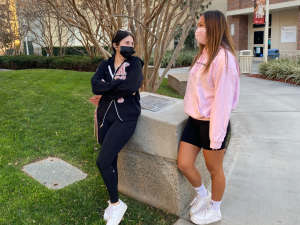
Nicole Drew, sophomore political science and philosophy double major, came in as a spring admit and expected that getting involved would help her get assimilated into college life.
Now, she can barely imagine a college experience untouched by this pandemic. By the time her freshman year had been cut short, she had spent less than two months on campus.
But all that is scheduled to change.
When classes resume after spring break, many students will have the choice to go straight to the physical classroom. Still masked, but zoom free.
Now, after receiving her vaccine, Drew can’t wait to get back onto campus. Drew, along with many other students, finally feels comfortable enough to return to campus.
She says,”A lot of my older professors are finally vaccinated. That, coupled with the fact that hospitalization, death, and infection rates are all time low, makes me feel like I’m finally ready to go back to class.”
Although Chapman is giving students the option of returning to hybrid classes, by no means does this mean that everything has returned to normal. With the abundance of precautions, many students still prefer to stay online for the rest of the semester. This upcoming partially hybrid format has resulted with much confusion and mixed sentiments from students and faculty alike.
Hybrid classes are a combination of in-person and online instruction. With that as an option, students have the choice between staying at home or returning to campus. Students who are unable to return or don’t feel comfortable, can continue to stay in a zoom learning environment while those who want to be back on campus can get that opportunity.
When students are not attending in-person classes, they are able to stream the lecture or watch it later as a recording.
“We have been asking faculty to be creative and innovative about how to encourage,” Dean of Students, Jerry Price said, “As an example, in the fall, I brought my iPad and set it on the podium so when I was looking at the live class, I also had the zoom students in front of me too.”
For those who have in-person and remote classes on the same day, Chapman has provided students with outdoor spaces on campus for students to use to attend their remote classes while being on-campus.
Like many other professors, English Professor Vik Jolly is choosing to transition his class to a hybrid format on March 29th.
“A majority of students in some of my classes seek in-person instruction and interaction after months of online learning,” Jolly said. “We all want to get on the other side of the pandemic as quickly as possible.”
The CDC guidelines warn gatherings and data suggests that the real risk of transmission is when you are in close proximity for 15 minutes or longer with an infected person. According to Chapman University’s website, the class sizes will depend on the physical class room’s capacity. All spaces on campus have designated maximum capacities, which will allow students to spread out accordingly.

According to Dean of Students and Vice President for Student Affairs, Jerry Price, Chapman is able to monitor COVID-19 cases in two ways: weekly rapid tests and daily COVID-19 health screening. Anyone that answers that they are experiencing COVID-19 symptoms through this health screening will not be cleared for a return on campus. Instead, they will be asked to quarantine and get tested.
For students who have missed their weekly rapid test, they will automatically not be sent the weekly email and they will need to be tested before coming on campus. For those living off-campus, the COVID-19 Daily Health Screening is only for those who voluntarily participate in the program.
“We feel really good about our weekly testing plan. It’s expensive, but we think that this helped us.” Price said, “For example, we have tested so far around 1600 people and only had 10 positive tests. Despite all the news and social media about big parties and super-spreaders we’re still testing students weekly at less than 1%”
In order to keep up with the need of testing, the Student Health Center is making sure that they’re hiring more part-time staff to administer the testing.
According to the LA Times, a little over 20% of Californians have received their first dose of the vaccine, with 9.5% having gotten both doses. Currently, Orange County has administered 928,662 doses.
Though Chapman University has been approved by the state to be a vaccination site, they have yet to receive the vaccines.
“It looks like most of the county’s energy is focused on big sites and maybe the pharmacy’s so we’re hoping still that we will get factions of our own, but it doesn’t seem like it’s coming out anytime soon.” Price said. “Plus students who don’t have a pre-existing condition are gonna be very far down on the list.”
Though Covid cases and hospitalization rates are going down, students still need to be wary. The California Department of Public Health (CDPH) has 4 categories of severity that we use to define how dire the pandemic is; purple (widespread), red (substantial), orange (moderate), and yellow (minimal).
These levels are categorized by the amount of cases out of every 100,000 in the county, percentage of positive cases, and the amount of positive cases for the health equity quartile. As the levels change, so do the requirements for what is or is not permissible by the state.
Chapman’s been following the CDPH requirements to a tee. In accordance to those guidelines, purple tier requirements ban indoor lectures while only exempting certain classes–like labs. Now that we’ve crept into red tier, California legally allows 25% capacity or 100 students within the class (depending on whichever is less) and lets lab and studio art classes continue at full capacity, but still asks that other student activities be kept online.
Though Chapman’s intent on keeping campus up to code with all CDPH requirements, not every student is ready to come back just yet.
Anais Padilla, a sophomore psychology major, is unsure if a campus return is even worth it at this point in the semester. To add to her workload as a full-time student, she also works as a student worker in FISH Interfaith Center and as a behavior interventionist. She feels like there’s already a groove to her current online work/school that a return would just needlessly interrupt.
She says, “I want to go back. I miss my friends and really wanna meet some of the professors I have this semester. But, I’m trying to determine if it’s worth it getting tested every single week because I don’t think I’m gonna have time to do that.”

Freshman international student Merdian Harrap, theatre performance major, was a little disappointed she wasn’t on campus to get the full experience. Unlike other Chapman students taking classes on zoom, Harrap’s zoom schedule looks a little different being in another time zone as she logs onto zoom in between 2 a.m. and 8 a.m. to attend her classes.
At the beginning of the year, Harrap made the decision to stay in Australia based on COVID-19 levels in America at the time. That way, she would remain with her family in case of an emergency. Despite campus possibly reopening mid-semester, she has chosen to stay home in Australia.
“It’s expensive to fly across the world, so I wouldn’t want to do that unless I was sure I would be getting more from being on campus than being home while also feeling like I was safe,” Harrap said.
As Chapman’s optional hybrid return creeps closer, students have to start deciding if hybrid is worth it.
Drew says,”I’m just at a place where I want to feel like I actually went to college. It feels safe to go back now, so I’m gonna take the chance to to feel like I reclaimed some of all the time I had lost.”


